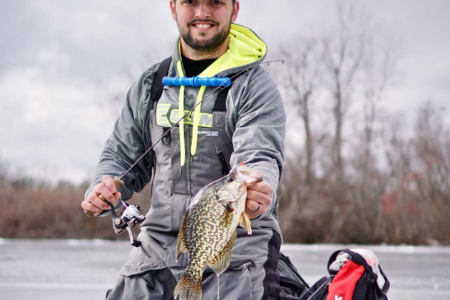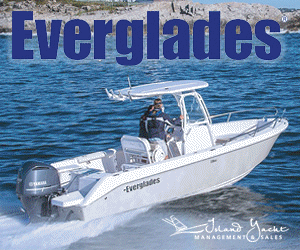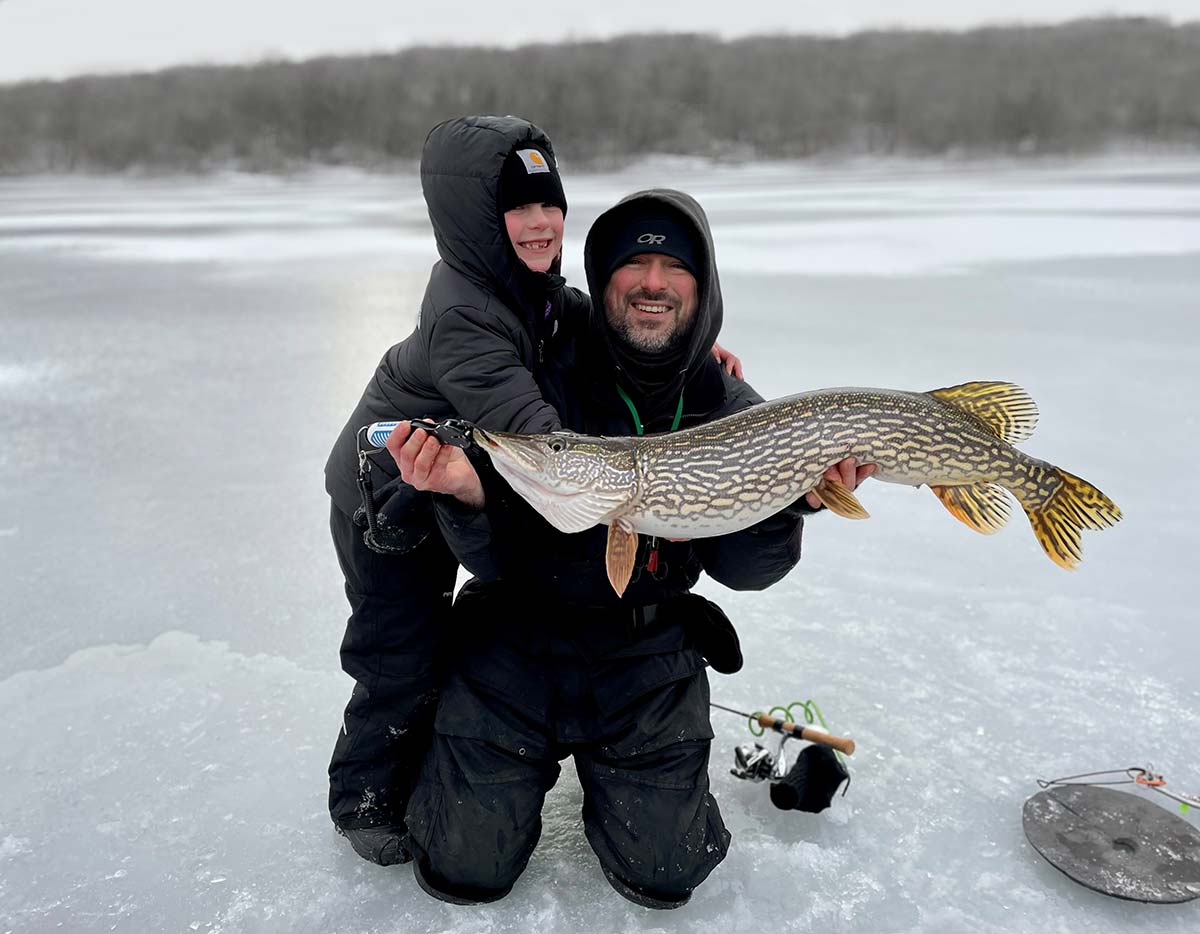
Incorporating rods into your tip-up spread can make ice fishing even more fun!
Bells are one of my favorite sounds in the world. Not because I’m a grown man that still believes in Santa, but when bells ring while ice fishing, it means that a fish is taking my bait.
Just last winter, a jigging rod with bells attached is how I introduced my daughter to her first northern pike. It was mid-January and we were set up on a weedy cove in Connecticut. In a spread of mostly traditional tip-ups, it was a bouncing rod with jingling bells that alerted us to a mid-30-inch fish on the other end of the line. I set the hook, handed Cora the rod, and the rest was history.
I’ll be the first to admit, I love ice fishing with classic tip-ups – it’s how I first got hooked on this winter pastime. Back then my equipment, and my plan of attack, was simple. We hand-drilled the precise number of holes needed for that outing, set our limit of wooden cross-style traps, and waited for flags to fly. Sometimes I yearn for that simplicity again. But as my winter obsession has grown so have the tools and toys at my disposal, which have paved the way to new styles and methods of ice fishing. It’s a never-ending loop.

Evolution Of Obsession
I still remember splurging on my first fishfinder and power auger that set in motion a passion for jigging through the ice. I have been incorporating the rod and reel more and more into my hardwater game plans ever since. What started plainly as dead-sticking a jigging rod with bells eventually led me down a rabbit hole of ice fishing systems that bridged the gap between trap fishing and jigging; devices that essentially convert a jigging combo into a tip-up.
There are a number of advantages to fighting a fish through the ice on a rod and reel compared to hand-lining with a tip-up. A key example is utilizing the reel’s drag system to control a fish versus applying pressure on braided line with cold fingers. Another to consider is line management. I can recall fighting fish on tip-ups during subzero days, pulling them in hand-over-hand as wet Dacron froze in a tangled mess around the hole. When a big fish decides to run in conditions like that, things can get ugly quick; not to mention that your fingers are out of commission for a while afterward.
| COLD, HARD FACTS |
| To learn more about these innovative trap systems, visit the websites below.
iFish Pro: www.ifishpro.com Arctic Warrior: www.clamoutdoors.com NE’78 & Wachusett: search ‘Indian Hill Trap Company’ on Facebook JawJacker: www.jawjackerfishing.com |
Also, as a parent of young kids, they are more comfortable fighting fish on a rod and reel compared to a hand-over-hand retrieve with tip-ups in freezing temps. At the end of the day, it boils down to personal preference. How do you like to ice fish? For me, ice fishing is all about having fun, and I’ve been experiencing a ton of that lately, thanks to more rods in my ice fishing spread.
We’re fortunate to be living in a golden age of ice fishing technology. I wanted to shed some light on a few of the many revolutionary ice fishing systems on the market today that integrate a rod and reel. Each of those described below have pros and cons and shine in particular situations. They all feature unique trigger mechanisms that alert the angler when a fish bites. Let’s dive in.
iFish Pro
The initial idea for the iFish Pro came in 2008 when Levi Christianson and his family were fishing on the famed Lake of the Woods. Using a traditional wooden tip-up, Levi’s younger brother, 11 years old at the time, was pulling in a big northern pike by hand and straightened out a snap swivel as he attempted to turn the fish up the hole. After losing the battle, he turned to his family and asked, “Why can’t we use a rod and reel?”
It was like a lightbulb going off. The family brainstormed the rest of the trip and when they got home, a prototype of plywood and PVC was born in their garage. It took 4 more years and a lot of hard work, but the first iFish Pro came off the factory line in 2012, and patents soon followed.
In the decade since, the iFish Pro has taken the hardwater scene by storm. This tip-up base has been a gamechanger for ice anglers who enjoy fishing set lines, yet also prefer to fight their quarry on a jigging rod.
The iFish Pro fits over holes up to 10-inches in diameter and its foam-insulated base helps prevent them from freezing up. Part of the tip-up’s sidewall is constructed higher to act as a deflector, reducing wind flags and snow buildup. It has an adjustable rod holder that can accommodate rods up to 42 inches and also folds and locks in place for transport.
“You can adjust the trigger release on this tip-up to light, medium, or heavy settings to avoid dealing with false flags and resets in icy temps,” said Christianson. “With the multi-setting capability and the easy-to-switch-out rod holder, this ice fishing tip-up is perfect for targeting any size species.”
The versatile iFish Pro can be purchased for $59.99 right from their website (www.ifishpro.com).

Arctic Warrior
Aside from revolutionizing the portable ice shelter market, Clam Corp has developed a long and varied line of hardwater products over the past 30 years. One is the Arctic Warrior, a simple yet effective tool that allows anglers to incorporate a rod and reel into their tip-up spread.
The Arctic Warrior consists of two main parts: a foldable tip-up base with a flag and a metal attachment that to the handle of your favorite jigging rod with Velcro. The rod is then balanced on the base and the flag is set. The length of the rod nor the size of the bait matter as much as locating the proper balance point on the rod handle.
“When using bigger baits, you must preload your balance point to counterweight the weight of your bait,” Clam’s Addy Hanson explained. “The whole system is based around the pivot, and the bigger the bait the more weight you need near the butt of the rod handle. It all comes down to a teeter-totter effect.”
When a fish tugs on the bait, the rod tips down and the flag is tripped. You then simply grab the rod, set the hook, and fight the fish. “The Arctic Warrior has a light trigger that is great for finicky fish that would likely drop it once they feel resistance,” said Hanson. Another perk is that the Arctic Warrior folds down into an extremely small footprint for easy pack up and storage.
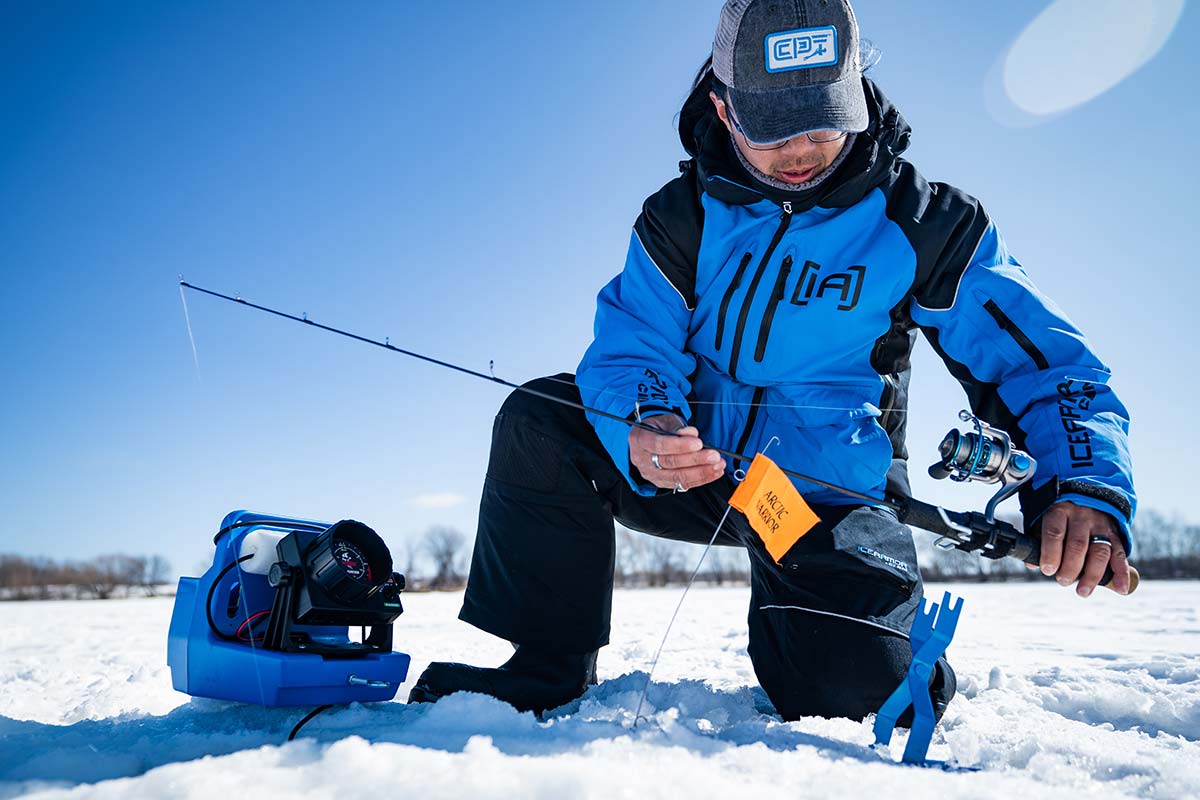
NE’78 & Wachusett
“It all started in Vermont,” said Mike DeVillers, the one-man show behind Indian Hill Ice Traps. While ice fishing on Lake Champlain, he and some buddies were unimpressed with a rod-and-reel tip-up they were trying out. So DeVillers got the bright idea to build one.
At the time, Indian Hill had already made a name for itself for making some of the finest hand-made tip-ups money could buy. Ever the perfectionist, DeVillers spent the next few winters tweaking the new contraption and eventually released it under the name Nor’Easter. It had the look and feel of a traditional wooden trap and was a big hit with his customers.
“The biggest thing I like about it is that it’s great for kids,” DeVillers said. “It’s hard to get a little kid to hand-line and not be all tangled in it, but it’s easy for them to hold a fishing rod. If you have the drag set right, they can handle a fish no problem.”
A few years ago, DeVillers retired the Nor’Easter and released a newer, beefed-up version. Since most anglers purchasing the original were using bigger rods for bigger gamefish like northern pike, he made the tip-up base longer and the upright taller. Named NE’78 after the monumental blizzard that slammed the Northeast in 1978, this second generation has small fold-out legs that provide a more stable base. So much so that anglers started using them in open water, particularly at Wachusett Reservoir. This gave DeVillers another idea – he made the NE’78 even bigger and sells them under the name Wachusett, naturally.
“What’s cool about the traps is that everything is adjustable,” said DeVillers. Extra holes have been drilled into each one so the rod holder can be moved, changing the rod angle. Another neat feature he added is a planer board to the center of each Wachusett, which addresses false flag issues anglers can run into when using extra-large baits. Put a tiny bit of line in the clip and big baits won’t trip the flag.
Indian Hill Ice traps have gained enough traction that some years it’s challenging for DeVillers to keep up with demand. The good news is that he was busy in his woodshop this fall and built 200 Wachusetts, as well as 100 NE’78s. You won’t find these tip-ups on Amazon or in big box stores; your best shot is to message DeVillers through his Facebook page: Indian Hill Ice Traps. Since each one is made by hand using solid ash and other top-quality materials, be prepared to fork over $65 for an NE’78 and $75 for a Wachusett.
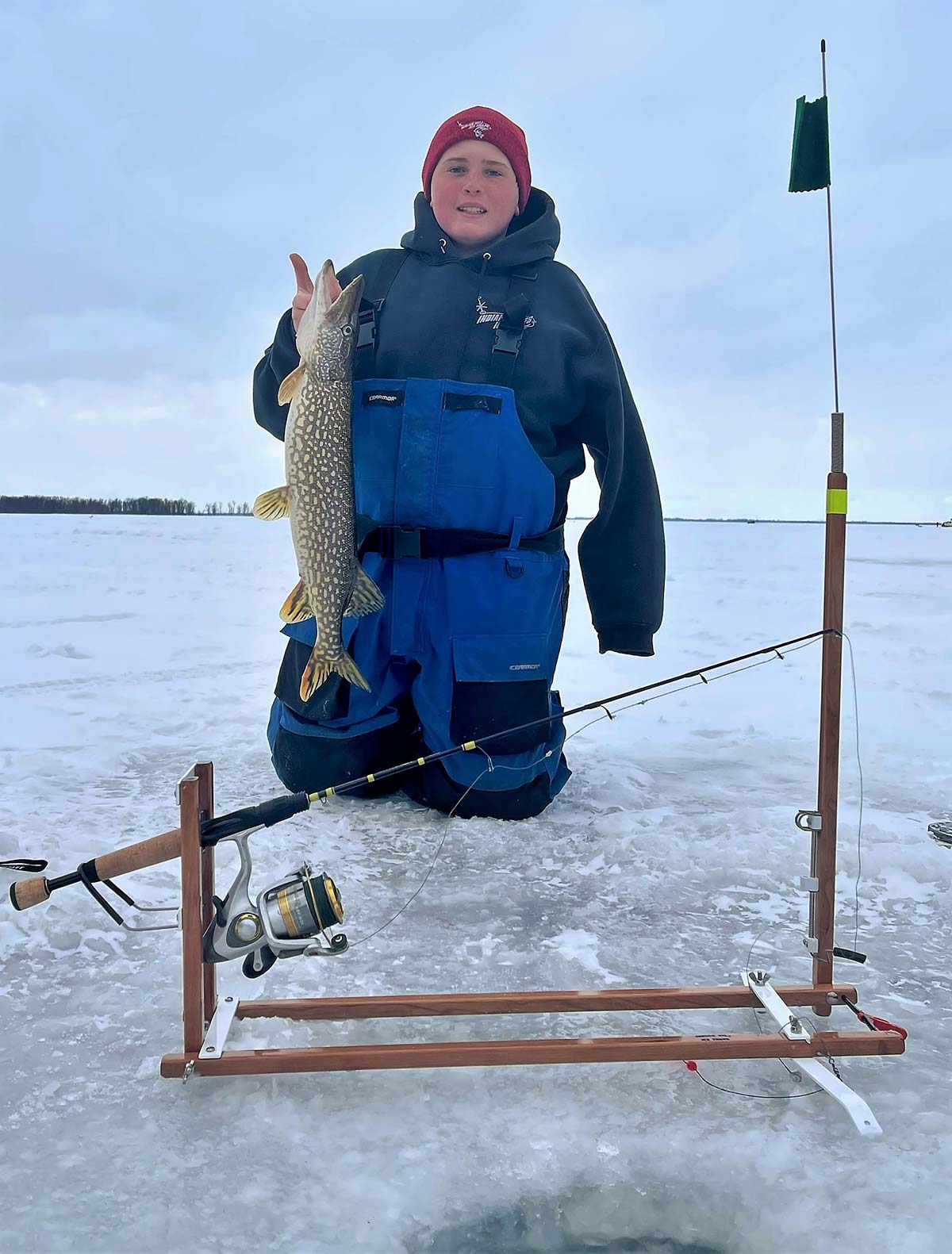
Jawjacker
The beginnings of the JawJacker can be traced back to Matt Dungan’s childhood in Tennessee. He grew up setting live-capture traps for possum and other critters in the woods behind his house. All these years later, Dungan still credits his knowledge of trapping trigger mechanisms for his design of the JawJacker. Setting it apart from the rest of the field, JawJackers do the hook-setting for you. In theory, the fish takes the bait, the trigger releases the rod tip, and the spring action from the bent rod instantly sets the hook.
“Being able to set the hook as soon as a fish bites is a huge advantage since fish tend to spit the bait quickly once they realize there is a hook attached to it,” said Dungan. “With a standard tip-up, a lot more time passes between when a fish takes the bait and when an attempt is made to set the hook.”
The JawJacker shines when targeting fish that can get the bait all the way in their mouth on the first bite. That’s why they are especially popular among trout enthusiasts, who often pair them with small jigheads tipped with bait like egg sacs, waxworms, or pieces of nightcrawler. “JawJackers will set the hook on bites you didn’t even know you were getting before,” said Dungan. “The trigger is very sensitive.”

JawJackers work with most ice fishing rods up to 36 inches, which should be stiff enough to adequately set the hook, yet not so stiff that your line breaks or hook straightens out. There is a pin in the rod holder for adjusting rod angle that helps control how hard the rod sets the hook. Another perk is that the JawJacker is light and compact; when folded up, you can fit a bunch in a five-gallon bucket.
JawJackers rarely gut-hook fish. Since the device doesn’t give fish time to swallow the bait, it hooks a high percentage of them right in the jaw. For that same reason, however, the hook-up ratio is not as high when using larger baits that the fish may not be able to take down in one bite. One way to increase hook-ups with bigger bait is to use strike rigs. And depending on bait size and target species, anglers can adjust the trigger tension from super light to heavy by adjusting a wingnut on the side of the device.
Dungan had a few pointers for JawJacker newbies. He stressed keeping holes clear of ice to ensure the trigger system can function properly, and moving it away from the hole when reeling in fish, as splashing water can get inside and freeze up the trigger mechanism. There is no flag on the JawJacker, the sound of the rod springing is often enough to alert an angler, but Dungan said bells can be added to the rod as an extra indicator.
The hook-setting JawJacker can be purchased for $59.99 right from their website (www.jawjackerfishing.com).



